California Oak Trees (With Pictures) – Identification Guide
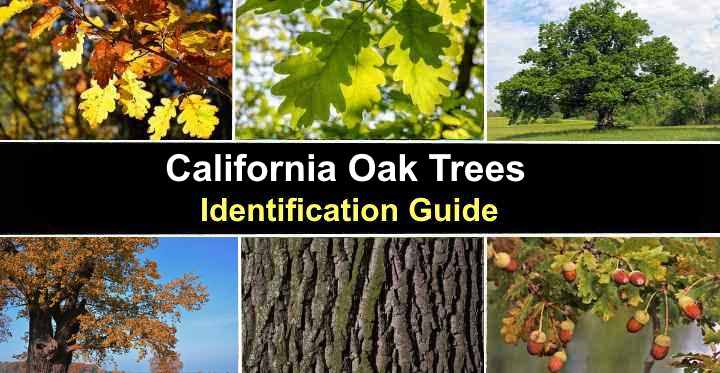
Oak trees are an integral part of California’s ecosystem and landscape. These majestic hardwood, broadleaf trees provide shade, beauty, and habitat for wildlife in the Bear Flag State. From native California oak trees like the California Live Oak, Black Oak, Canyon Oak, and Channel Island Oak to naturalized oak trees, these deciduous trees are common throughout the western United States.
Although California is famous for its giant sequoias and huge redwood trees, oak trees are common throughout the state. The deciduous oak trees are identified by their rounded, spreading crowns, deeply lobed leaves, acorns, and rough, gray bark. California is home to various species of oak trees like red oaks, white oaks, live oaks, and the blue oak tree.
This article is an identification guide to help you recognize and distinguish between the different species of oak trees found in California. With pictures and descriptions of their unique features, you can easily identify these majestic trees.
California Oak Tree Facts
Over 20 species of oak trees are native to California. These native trees thrive in the diverse climate of the Pacific coastal regions, with hot, arid conditions in the southwest and humid, mountainous areas in northern California. California oaks are found in 52 of the state’s 58 counties.
The three most common varieties of oak trees in California are the valley oak (Quercus lobata), blue oak (Quercus douglasii), and interior oak (Quercus wislizenii). From these native oaks, the valley oak is the tallest variety and grows over 100 ft. (30 m) tall.
California White Oak Trees

White oak lobed leaves have rounded tips
White oak trees, native to California, are large, imposing trees, identified by their leathery leaves with deep, rounded lobes. Species of white oak have grayish-brown bark that develops shallowly furrowed ridges. White oaks have finger-like clusters of yellowish-green flowers before producing chestnut-brown acorns.
White oaks typically grow 60 to 100 ft. (18 – 30 m) tall, depending on the species. In the fall, the lobed, green leaves turn eye-catching shades of yellow before dropping.
California white Oaks are extremely drought-tolerant and can thrive in various types of soils and climates. They can also withstand short periods of flooding, making them an ideal tree to plant anywhere in the state.
California Red Oak Trees

Red oak lobed leaves have irregular bristle tips
Red oak trees in California are identified by their lobed leaves with bristled tips. Unlike white oak leaves, the foliage on red oaks tends to have a spiky appearance. In the fall, the leaves turn an impressive russet red to scarlet color.
You can tell white oaks apart from red oaks in California because their bark is generally light gray. In contrast, red oaks have dark, nearly black bark.
Red oaks usually grow 60 to 75 ft. (18 – 22 m) high and up to 45 ft. (13 m) wide.
California Live Oak Trees
California live oak trees are evergreen trees that thrive in warmer regions of California. Live oak trees are characterized by their dark green, holly-like leaves, pendulous flower clusters, and deeply-furrowed bark. Their brown acorns are slender egg shaped with a pointed apex. Smaller than other oaks, these trees grow 20 to 50 ft. (6 – 15 m) tall.
California Oak Tree Bark
The bark on California oak trees is smooth and silvery-brown during the early stages of tree growth. The bark becomes deeply grooved and raised as the tree matures, resulting in a rough and fissured texture.
California Oak Tree Leaves
Leaves on California oak trees make it easy to distinguish the majestic trees from other trees. Most oaks have obovate leaves with five to nine rounded or pointed lobes. White oak leaves tend to have a rounded apex and round lobes. On the other hand, red oak leaves have pointed, bristle-tipped lobes. However, evergreen live oaks are oval and have a thick, leathery feel with sharp spines around the margins.
California Oak Tree Acorns
Oak tree nuts or acorns are easily identifiable features of these trees. Oak acorns are usually shades of light to dark brown and sit in a cap-shaped cup or cupule. Acorns also help differentiate between species of oak—some have rounded acorns, whereas other oak trees have pointed nuts.
A difference between acorns growing on white oaks from those on red oaks is how long they take to mature. White oak tree acorns mature in one season and will germinate in the fall. In contrast, red oak acorns take two growing seasons to mature.
California Oak Tree Flowers
California oak tree flowers are bright yellow or yellowish-green catkins—finger-like clusters dangling from woody stems. These fuzzy clusters bloom in spring at the same time the leaves emerge. Oak trees are monoecious, meaning that male and female flowers grow on the same tree.
California Oak Tree Identification
The way to identify California oak trees is by examining the leaf shape, acorns, and tree bark.
The leaves can be smooth or lobed and may have small hairs on the underside. Some oaks have round-lobed leaves, while others have pointed or deeply cut edges. Additionally, take note of the acorn shape. Some have larger cups than others; although most acorns are egg-shaped, some oak species have pointed acorns.
Types of California Oak Trees (With Pictures)
Let’s look in detail at many types of California oak trees—native and non-native varieties—that grow throughout the Golden State.
Valley Oak (Quercus lobata)
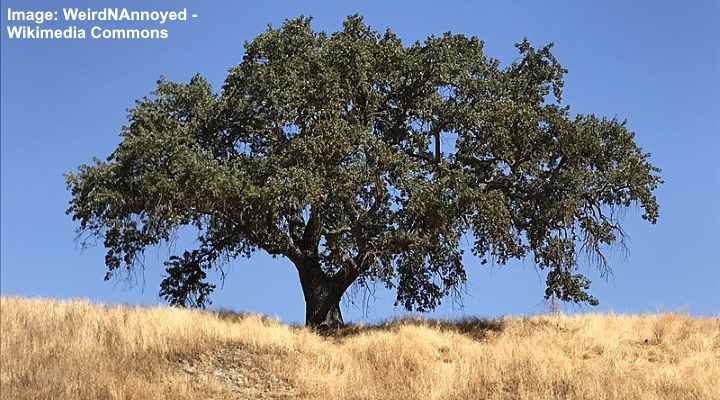
Valley oak tree (Quercus lobata)
One of the largest species of California oak is the valley oak. This large, deciduous tree is endemic to California. It grows up to 100 ft. (30 m) and has wide-spreading branches creating a crown 50 ft. (15 m) in diameter. The acorns are medium to dark brown, pointed, and sit in a thick, scaly cup.

Valley oak leaves and bark
California oak tree bark: Valley oak bark is identified by its distinctive ridged bark with small scales resembling alligator skin.
California oak tree leaves: Valley oak leaves measure 2” to 4” (5 – 10 cm) long with round lobes and cuts that almost reach the midrib.
California oak tree fact: The largest valley oak in California is the Henley Oak which measures 153 ft. (47 m) tall.
Interior Live Oak (Quercus wislizenii)

Interior live oak (Quercus wislizenii)
The interior live oak is an evergreen California oak tree native to the southwestern United States. It is a slow-growing, drought-tolerant tree that can reach up to 72 ft. (25 m) tall and has a broad, spreading crown. The interior live oak is known for its long, narrow and pointed acorns.
The interior live oak is native to California’s coastal range to the Sierra foothills.

Interior live oak leaves can have spiny margins on young trees at higher elevations or smooth margins
California oak tree bark: The interior live oak has grayish bark that becomes furrowed and forms checkered scales.
California oak tree leaves: The interior live oak has thick, leathery leaves that are dark green on top and pale underneath. They are oval or elliptical and have smooth or toothed edges like holly leaves. The leaves remain green throughout the year, adding color to California landscapes in summer and winter.
California Live Oak (Quercus agrifolia)
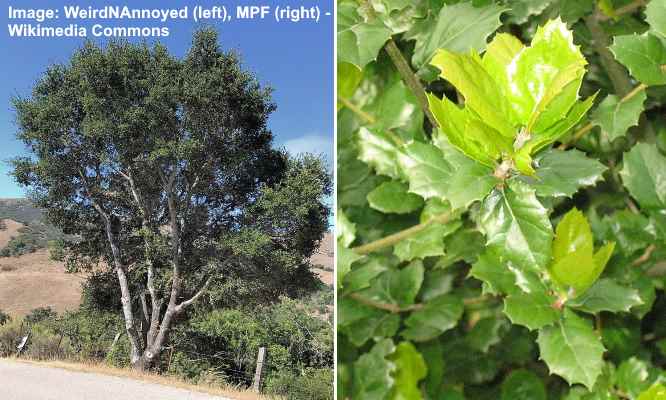
California live oak tree (Quercus agrifolia)
Native to California’s coastal regions, the coast live oak is a large evergreen oak with a dense, rounded crown and gnarled, spreading branches. In addition, this evergreen oak has narrow, pointed tip reddish brown acorns measuring 0.78” to 1.37” (2 – 3.5 cm) long. In California, these native oaks grow 30 to 80 ft. (10 – 24 m) tall and wide.
The coast live oak thrives in USDA zones 9 to 11 and is found along the Pacific coast from Sacramento to San Diego.
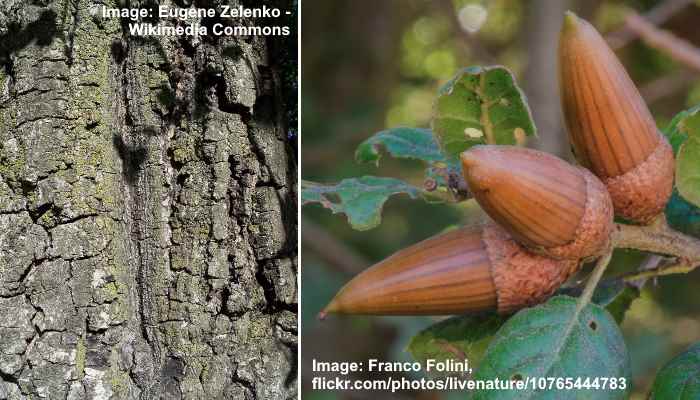
Coast live oak tree bark of a mature tree and acorns
California oak tree bark: California live oak tree bark is smooth and gray on young specimens and becomes dark gray with deep fissures and ridges on mature trees.
California oak tree leaves: California live oak tree leaves are dark green and have an oblong shape with wavy, spiny-toothed edges. The leaves measure up to 0.78” to 2.75” (2 – 7 cm) long and have a leathery feel.
Blue Oak (Quercus douglasii)
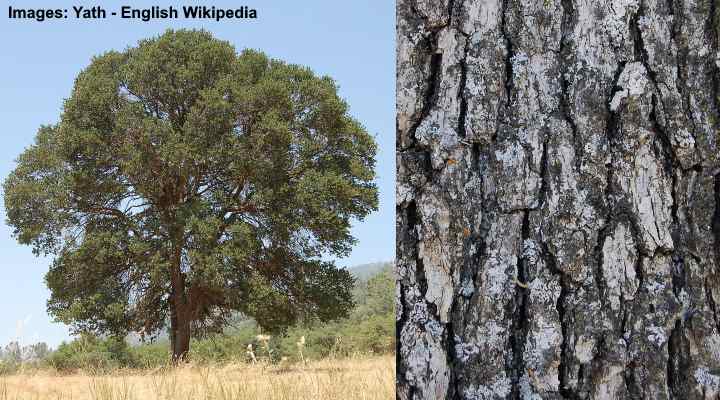
Blue oak (Quercus douglasii) tree and bark
Also called the mountain oak, the blue oak is a deciduous oak tree species that grows in California’s oak woodlands. It’s a drought-tolerant tree identified by stout, crooked branches, bluish-green leaves, and brown, egg-shaped pointed acorns. This native California oak grows 30 to 50 ft. (9 – 15 m) tall with a spreading crown 70 ft. (21 m) wide.
Suitable for growing in USDA Zone 6 to 9, the blue oak thrives in the foothills of the South and North Coast Ranges, the Central Valley, and the San Francisco Bay area.
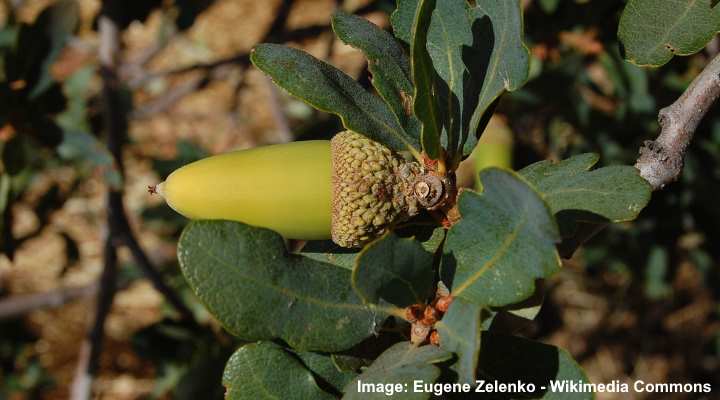
Blue oak acorn and leaves
California oak tree bark: Blue oak tree bark is light gray and has shallow furrows forming small checkered patches.
California oak tree leaves: Blue oak tree leaves are a unique blue-gray color and have shallow lobed margins. The oak leaves measure 4” (10 cm) long and turn attractive yellow, orange, and pink shades in the fall.
California Black Oak (Quercus kelloggii)
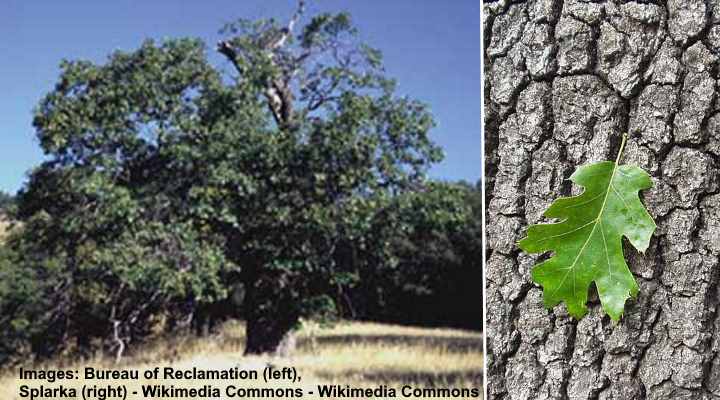
California black oak (Quercus kelloggii) tree, bark and leaf
The California black oak is a large deciduous oak tree belonging to the red oak section. The attractive oak tree has a broad, rounded crown and grows 30 to 80 ft. (9 – 24 m) tall, with a trunk diameter of up to 4 ft. (1.2 m).
This native California black oak tree is easy to identify thanks to its large egg-shaped acorns measuring 1” to 1.5” (2.5 – 4 cm) long. The California black oak thrives throughout the state, from the Pacific Ocean in the west to the Nevada desert in the east.
California oak tree bark: California black oak bark is dark gray to black and ridged with blocky patterns on the trunk.
California oak tree leaves: California black oak leaves measure 4” – 9.75” (10 – 25 cm) long. The leaves feature seven deep lobes and emerge red, turn green in summer, and then orange-brown in the fall.
Channel Island Oak (Quercus tomentella)
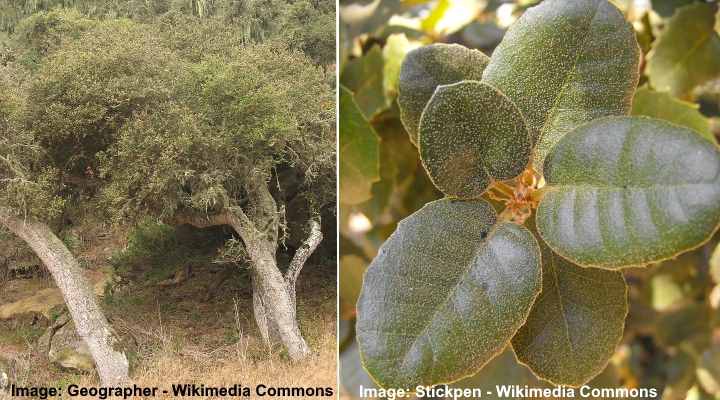
Channel Island oak (Quercus tomentella) tree and leaves
Channel island oak trees are found on the six islands off California’s coastline. The Channel island oak tree has a rounded crown and grows 66 ft. (20 m) tall. Characteristics of the heat-loving oak are its reddish-brown trunk, leathery leaves, and acorns with rounded tips.
The Channel island tree’s acorns grow 1.37” (3.5 cm) long and 1.1” (3 cm) wide. Being a species of red oak, the acorns take two years to mature.
California oak tree bark: Channel Island oak tree bark is recognized by its grayish to reddish-brown furrowed bark with a scaly texture.
California oak tree leaves: Channel Island oak evergreen leaves have pointed or rounded tips, and the edges can be smooth or toothed. The leaves measure 2.75” to 4” (7 – 10 cm) long.
Canyon Live Oak (Quercus chrysolepis)
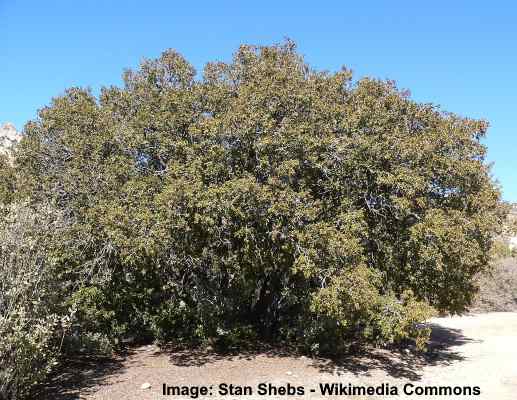
Canyon live oak (Quercus chrysolepis)
Also called golden cup oak, the canyon live oak is a native evergreen tree to California’s Coast Ranges. The evergreen oak is identified by its rounded, spreading crown, glossy green leaves, and grayish-brown bark. The tree’s acorns are egg-shaped nuts and sit in shallow, thick, scaly cups. The canyon live oak grows 20 to 100 ft. (6 – 20 m) tall and prefers well-draining soil.
In some places of California, the small oak tree grows as an evergreen shrub. However, the largest specimen trees of 80 to 100 ft. (24 – 30 m) are found in Southern California.
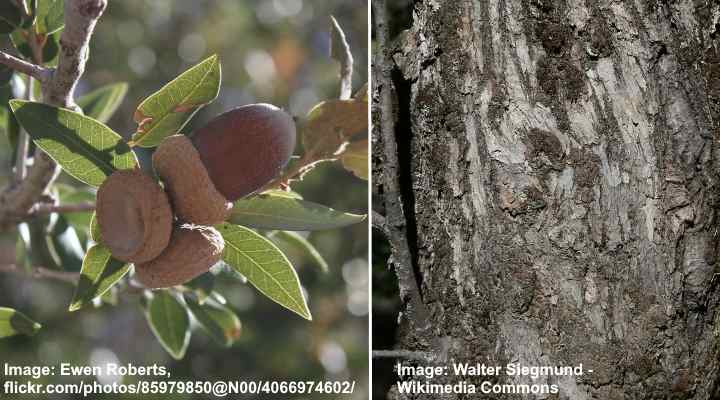
Canyon live oak leaves, acorns and bark
California oak tree bark: The canyon live oak has dark-brown bark. Sometimes the bark is smooth in shrub-like trees but can become scaly with irregular plates in mature trees.
California oak tree leaves: The glossy green evergreen leaves of the canyon live oak measure 1” to 3.25” (2.5 – 8 cm) long. The leathery leaves are smooth or have spiny teeth along the edges, especially on young branches.
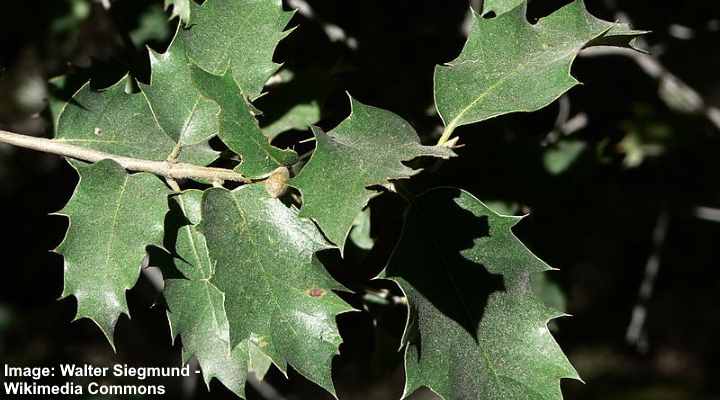
Canyon live oak leaves can have spiny margins on young branches
Oregon Oak (Quercus garryana)
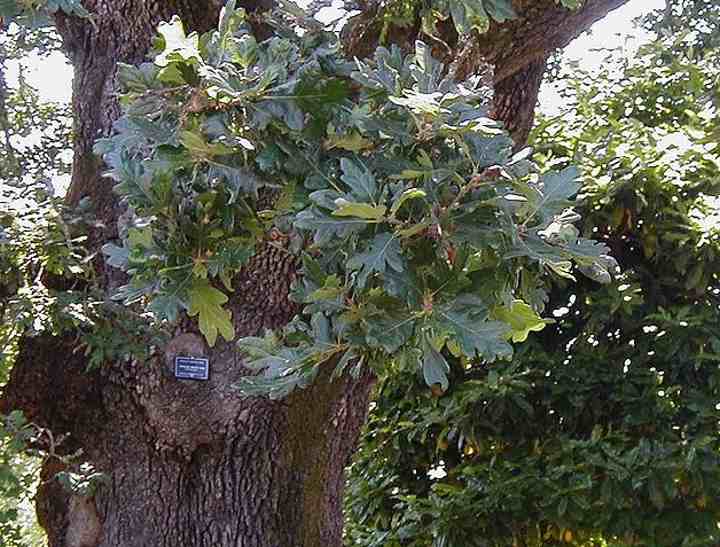
Oregon oak bark and leaves
The Oregon oak, also known as Garry oak, is a native California white oak tree that grows throughout the Golden State. The deciduous tree has a broad, rounded crown and grows up to 80 ft. (24 m) tall. Its acorns are small tan-colored nuts measuring up to 1” (2.5 cm) and sitting in shallow, warty cups.
The Oregon white oak has a range from Los Angeles north to Washington State.
California oak tree bark: Oregon oak tree bark is dark gray with deep furrows and ridges and surrounds a trunk 3 ft. (1 m) thick.
California oak tree leaves: Oregon oak tree leaves are elliptical with three to seven deep lobes. The glossy green leaves measure 2” to 6” (5 – 15 cm) and turn an unimpressive brown color in the fall.
California Scrub Oak (Quercus berberidifolia)
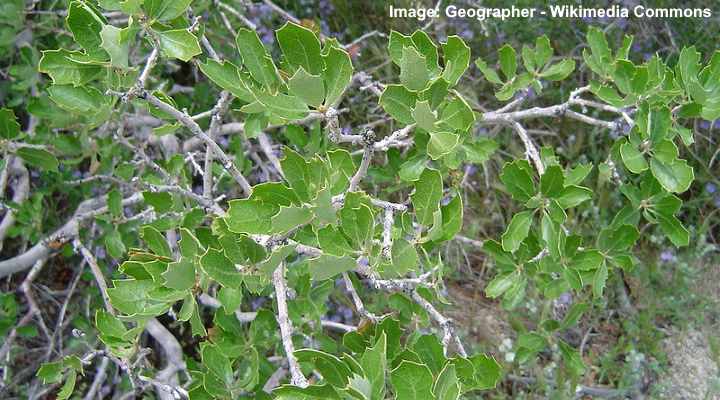
California scrub oak (Quercus berberidifolia) leaves
The California scrub oak is a small, evergreen shrub-like oak tree that grows in the hills of California. The small shrub or tree grows 3.5 to 6.5 ft. (1 – 2 m) tall and is characterized by a twisted trunk and branches. This species of white oak produces ovoid acorns 1” (2.5 cm) long.
In sheltered, warm areas of California, it’s not unusual for the scrub oak to grow up to 13 ft. (4 m) high.
California oak tree bark: The California scrub oak has rough, brownish bark that is thin and flaky.
California oak tree leaves: The California scrub oak leaves are leathery, dull green with sharp spines around the margins. The elliptical to oblong leaves measure 0.60” to 1.20” (1.5 – 3 cm) long. The evergreen foliage drops in dry seasons.
California oak tree fact: This botanical name of the Canyon live oak means “barberry-leaved,” referring to its jagged leaves.
Engelmann Oak (Quercus engelmannii)
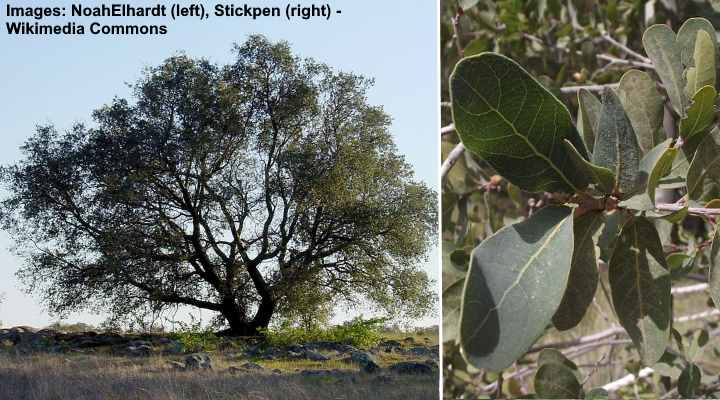
Engelmann oak (Quercus engelmannii) tree and leaves
The Engelmann oak tree is a rare and endangered species native to Southern California. The evergreen tree has an open, rounded, irregular crown with spreading branches. The fast-growing oak trees grow 33 ft. (10 m) tall. Its acorns are barrel-shaped, chestnut brown, and sit in scaly cups.
The relatively small Engelmann oak tree prefers dry, well-drained soils. In dry seasons, the oak becomes drought-deciduous, meaning they lose their foliage in dry spells. They thrive in savannas and woodlands from San Diego to Los Angeles.
California oak tree bark: Engelmann oak tree bark is grayish-brown, smooth on young trees, and develops deep fissures and ridges as it matures.
California oak tree leaves: Engelmann oak tree leaves are dark bluish-green, leathery, and have wavy, smooth margins. The leaves measure 1.25” to 2.25” (3 – 6 cm) long.
Santa Cruz Island Oak (Quercus parvula)
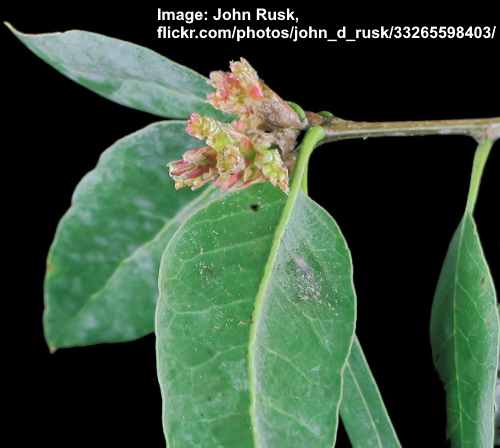
Santa Cruz Island oak (Quercus parvula var. parvula) leaves
The Santa Cruz Island oak is a type of red oak tree native to the California Coastal Ranges and Santa Barbara. The tree has a small, twisted trunk and branches that form a dense, vase-shaped, upward-spreading crown. Santa Cruz Island oaks produce large, elongated oval acorns in large, brown warty cups.
Santa Cruz Island oaks grow 56 to 72 ft. (17 – 22 m) tall.
California oak tree bark: Santa Cruz Island oak tree bark is gray to brown with irregular shallow furrows and ridges, creating a rough texture.
California oak tree leaves: Santa Cruz Island oak tree leaves are small, leathery lance-shaped blades with greenish-yellow veining and a pointed apex. They measure 1.6” (4 cm) long.
The Shreve oak (Quercus parvula var. shrevei) is related to the Santa Cruz Island oak and looks similar.
Pin Oak (Quercus palustris)
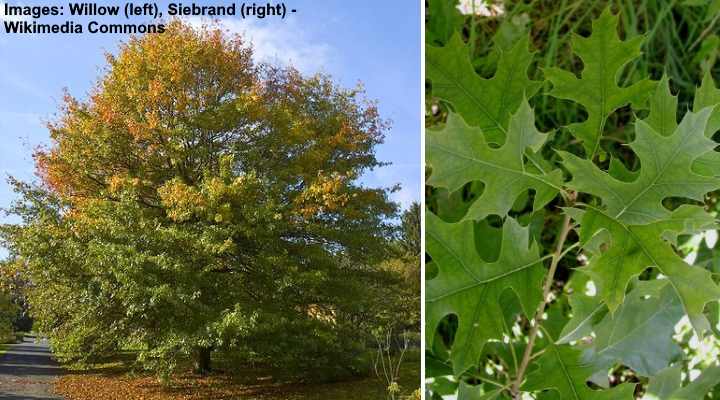
Pin oak (Quercus palustris) tree and leaves
The pin oak is a fast-growing deciduous oak tree with spectacular red fall colors and an eye-catching branching pattern. The trunk is barely noticeable due to lower branches drooping down. The upper canopy of the pin oak has loose, spreading growth. In addition, the oak tree produces small acorns 0.60” (1.5 cm) tall and enclosed by a thin saucer-like cup.
Pin oak trees grow 50 to 70 ft. (15 – 21 m) in height. The species of red oak tree is commonly used as a landscape tree and is prized for its beautiful fall color. Despite being native to the eastern United States, the pin oak thrives in cooler regions of California.
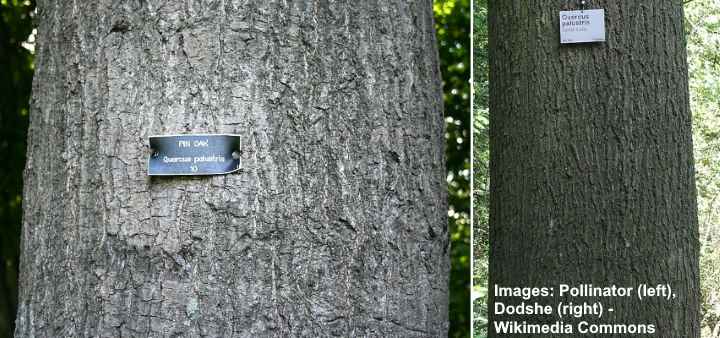
Example of pin oak bark
California oak tree bark: Pin oak bark is smooth and greenish-brown on younger trees before developing shallow furrows and ridges forming diamond-shaped patterns.
California oak tree leaves: Pin oak tree leaves have five to seven deeply cut, sharply pointed lobes with bristle-tipped ends. The leaves turn a bright russet-red to crimson color in the fall.
Related articles:
- Florida Oak Trees – Identification Guide
- Texas Oak Trees – Identification Guide
- Types of Oak Acorns – Identification
